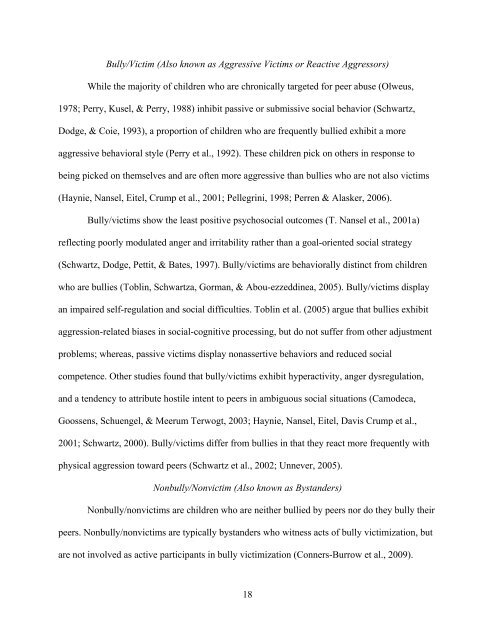Copyright Malvin Porter, Jr. 2010 - acumen - The University of ...
Copyright Malvin Porter, Jr. 2010 - acumen - The University of ...
Copyright Malvin Porter, Jr. 2010 - acumen - The University of ...
Create successful ePaper yourself
Turn your PDF publications into a flip-book with our unique Google optimized e-Paper software.
Bully/Victim (Also known as Aggressive Victims or Reactive Aggressors)<br />
While the majority <strong>of</strong> children who are chronically targeted for peer abuse (Olweus,<br />
1978; Perry, Kusel, & Perry, 1988) inhibit passive or submissive social behavior (Schwartz,<br />
Dodge, & Coie, 1993), a proportion <strong>of</strong> children who are frequently bullied exhibit a more<br />
aggressive behavioral style (Perry et al., 1992). <strong>The</strong>se children pick on others in response to<br />
being picked on themselves and are <strong>of</strong>ten more aggressive than bullies who are not also victims<br />
(Haynie, Nansel, Eitel, Crump et al., 2001; Pellegrini, 1998; Perren & Alasker, 2006).<br />
Bully/victims show the least positive psychosocial outcomes (T. Nansel et al., 2001a)<br />
reflecting poorly modulated anger and irritability rather than a goal-oriented social strategy<br />
(Schwartz, Dodge, Pettit, & Bates, 1997). Bully/victims are behaviorally distinct from children<br />
who are bullies (Toblin, Schwartza, Gorman, & Abou-ezzeddinea, 2005). Bully/victims display<br />
an impaired self-regulation and social difficulties. Toblin et al. (2005) argue that bullies exhibit<br />
aggression-related biases in social-cognitive processing, but do not suffer from other adjustment<br />
problems; whereas, passive victims display nonassertive behaviors and reduced social<br />
competence. Other studies found that bully/victims exhibit hyperactivity, anger dysregulation,<br />
and a tendency to attribute hostile intent to peers in ambiguous social situations (Camodeca,<br />
Goossens, Schuengel, & Meerum Terwogt, 2003; Haynie, Nansel, Eitel, Davis Crump et al.,<br />
2001; Schwartz, 2000). Bully/victims differ from bullies in that they react more frequently with<br />
physical aggression toward peers (Schwartz et al., 2002; Unnever, 2005).<br />
Nonbully/Nonvictim (Also known as Bystanders)<br />
Nonbully/nonvictims are children who are neither bullied by peers nor do they bully their<br />
peers. Nonbully/nonvictims are typically bystanders who witness acts <strong>of</strong> bully victimization, but<br />
are not involved as active participants in bully victimization (Conners-Burrow et al., 2009).<br />
18

















